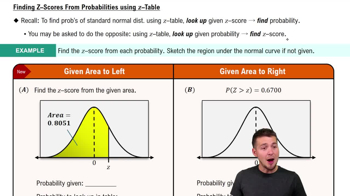Using and Interpreting Concepts
Finding Area In Exercises 17–22, find the area of the shaded region under the standard normal curve. If convenient, use technology to find the area.
 Verified step by step guidance
Verified step by step guidance Verified video answer for a similar problem:
Verified video answer for a similar problem:



 9:47m
9:47mMaster Finding Standard Normal Probabilities using z-Table with a bite sized video explanation from Patrick
Start learning